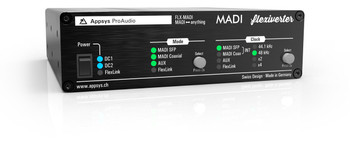Description
MADI Router
12 Port MADI Digital Patch Bay & Format Converter
MADI Distribution
As MADI systems grow, they may require a central router to distribute and merge streams and individual channels. The MADI Router is a device that can be used to split MADI signals into several outputs, or combine audio channels from several inputs into one signal.
Connectivity and Features
- 4 x MADI I/O coaxial
- 4 x MADI optical I/O
- 4 x MADI I/O twisted-pair (TP)
- 1 x Word Clock I/O
- USB for firmware & remote control
Building on the eight year success of the MADI Bridge and the MADI Converter, RME presents a newly designed device that is a worthy successor of both - in fact, its innovative core will redefine and inspire MADI systems for years to come.
The MADI Router is a compact device designed to link MADI devices of any manufacturer with unprecedented flexibility in signal routing. It provides this flexibility by serving as a format converter between optical and electrical signals, as a signal repeater, and as a distributor and merger of several MADI signals, all at the same time. The MADI Router combines many advantages of point-to-point audio connections, such as low latency and fast recovery time from signal line interruptions, with the flexibility of networked audio connections in which any device has access to any channel available on the network of connected devices.
At the simplest level input signals are passed on to the desired output unaltered. This type of connection is beneficial when manufacturers have embedded additional status or remote control data information in the MADI stream.
It is also possible to create new arrangements of audio channels within a MADI output stream. For this purpose four independent matrices are provided, each one reflecting 768 IN x 64 OUT audio channels. Any channel of any valid MADI input stream may be source to each crosspoint matrix. The output of each matrix can then be passed on to any of the 12 MADI Router's outputs.
Easy to Operate
The MADI Router is designed to be simple and easy to operate. It is the only MADI routing device on the market that can be completely programed and controlled without the help of external remote control software. In order to achieve this capability, a TFT display has been integrated on the front panel. It conveniently shows the current state of the device and leads the user through all required settings that are needed to set up a network. User interaction is conducted by four buttons and two rotary encoders surrounding the display.
The complete state of the device is saved with any user interaction (AutoSave) and automatically recalled within ten seconds after the unit is switched back on. Additionally, 15 internal presets let users save and recall, as well as preview and preselect routings.
On its back, the device provides a variety of connectors to achieve maximum compatibility and versatility for a broad range of different use cases. Four optical and four coaxial MADI inputs are accepting MADI signals at any sampling rate and channel format, the outputs carry either a refreshed or one of the four newly created MADI signals over distances of up to 200m (coaxial) or 2000m (optical).
MADI TP Connection
A novelty among RME devices are the MADI TP ports. These four combined in- and outputs bring MADI to common twisted pair network cables that can directly connect MADI TP devices over distances of up to 150m while passing on power along with the MADI signals. The four MADI TP ports provide sufficient power for the AES3 and ADAT Converters.
All twelve MADI ports are completely independent but grouped symmetrically in four sections ‘A’ to ‘D’ for quick identification. The word clock input may be used as reference to any of the four routing matrices or simply be refreshed and passed on to the output. The word clock output can further provide the extracted word clock signal from any of the 12 MADI inputs.
Two redundant 100W switching power supplies provide sufficient power for the MADI Router itself plus up to eight additional passive devices that draw their power from the MADI TP connections. The AC inlets support a locking mechanism that can be used with matching, optional AC power cords.
Specifications
General
Power supply: Two internal redundant power supplies, 100-240V AC, max. 100W
Dimensions without rack ears (WxHxD): 440 x 44 x 240 mm (17.32” x 1.73” x 9.45”)
Temperature range: +5° up to +50° Celsius (41° F up to 122°F)
Relative humidity: < 75%, non condensing
Weight: 2.8 kg
MADI Inputs
Coaxial via BNC: 75 Ohm, according to AES10-1991
Level range: High-sensitivity input stage (< 0.2 Vpp)
Connector: Optical via FDDI duplex SC connector
Compatibility: 62.5/125 and 50/125 multimode compatible
Compatibility: Both Optical and Coaxial ports accept any MADI signal
Connector: Twisted Pair via RJ45 connector (input and output)
Pinout “EXT”: 1-2 receive, 3-6 send, 4-5 DC +48V, 7-8 -48V
Inputs | Word Clock
BNC connector: not terminated (10 kOhm)
Switch for internal termination: 75 Ohm
Signal Adaptation Circuit: signal refresh through auto-center and hysteresis
Protection Overvoltage protection
Level range: 0.7 Vpp – 3.3 Vpp
Outputs | MADI
Coaxial via BNC: 75 Ohm, according to AES10-1991
Output voltage: 750 mVpp
Cable length: up to 200 m
Optical via FDDI: duplex SC connector
Compatibility: 62.5/125 and 50/125 multimode compatible
Fiber length: up to 2000m
Outputs | Word Clock
Connector: BNC
Max. output voltage: 3.3 Vpp
Output voltage @ 75 Ohm: 1.65 Vpp
Impedance: 10 Ohm
Frequency range: 27 kHz – 200 kHz


















